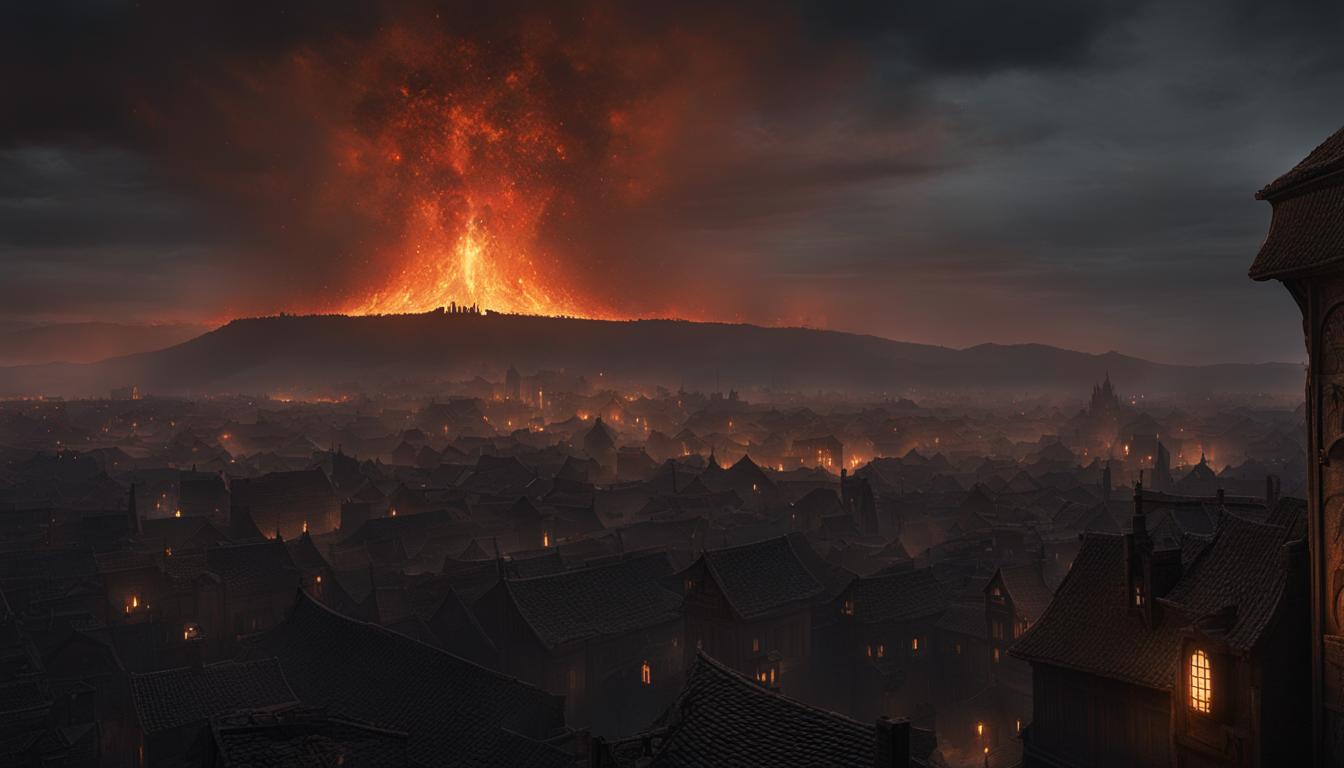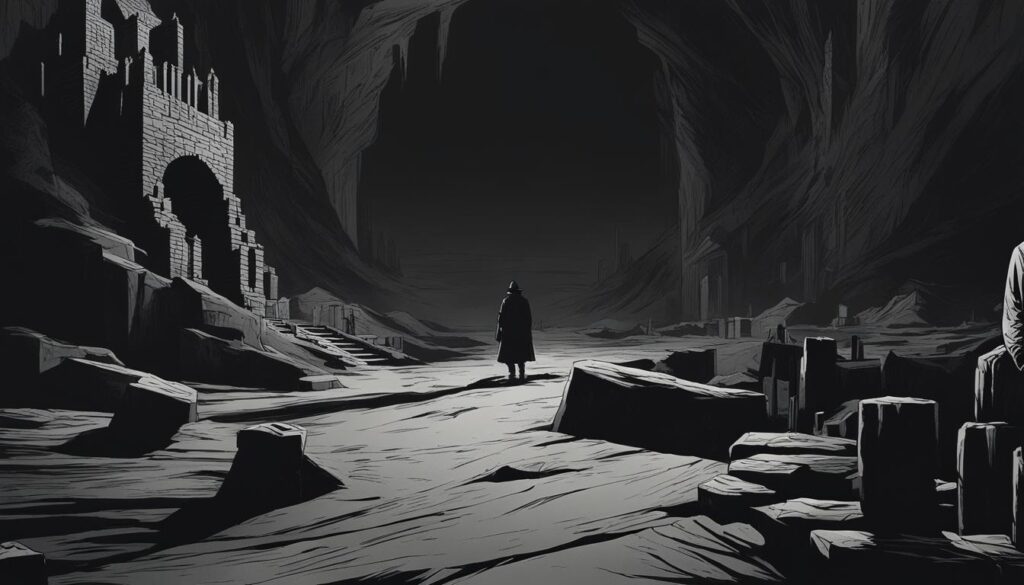Welcome to my article on “The Golem: How He Came into the World (1920),” a German silent horror film that delves into the golem myth from Jewish folklore. Directed by Paul Wegener, this film is a significant example of early horror cinema in the silent film era, set in the Weimar Republic.
Key Takeaways:
- “The Golem: How He Came into the World (1920)” is a German silent horror film based on the golem myth from Jewish folklore.
- Directed by Paul Wegener, the film is considered one of the earliest examples of horror cinema in silent films.
- The golem legend revolves around Rabbi Loew and his creation of a clay statue brought to life to protect the Jews of Prague.
- Paul Wegener’s fascination with the golem myth led him to create multiple films featuring the golem character.
- The film’s visual style draws inspiration from German Romantic cinema rather than Expressionism.
The Legend of the Golem
The legend of the golem is deeply rooted in Jewish folklore and has captivated people for centuries. It revolves around the figure of Rabbi Loew, a renowned Jewish scholar and leader in Prague during the 16th century. According to tradition, Rabbi Loew created a golem, a creature made of clay, in order to protect the Jewish community from persecution and harm.
The golem was brought to life through ancient rituals and inscribed with Hebrew letters, which imbued it with supernatural powers. The creature was incredibly strong and served as a loyal guardian, carrying out the rabbi’s commands and defending the Jewish people against their enemies.
Prague, the capital of the Czech Republic, is the setting for the golem legend. The city itself is steeped in history and mystique, providing the perfect backdrop for a tale of mysticism and religious devotion. The legend of the golem continues to captivate audiences around the world, with its themes of power, redemption, and the eternal struggle between good and evil.
“The golem represents the human desire for protection and security, as well as the potential dangers of unchecked power. It is a symbol of the extraordinary lengths people will go to defend what they hold dear.”
The legend of the golem serves as the basis for numerous literary works, plays, and films. Its enduring popularity is a testament to the timeless appeal of folklore and the universal themes it explores. Through the legend of the golem, we are reminded of the power of storytelling and its ability to capture our imaginations across generations.
Paul Wegener’s Inspiration
During the production of “The Student of Prague” in 1913, I came across the fascinating legend of Rabbi Loew and his creation of the golem. The tale immediately captivated my imagination, and I saw the potential to bring this ancient story to life through the medium of cinema. Inspired by the golem myth and motivated by my own cinematic vision, I embarked on the journey to create my own film adaptation of this timeless legend.
As a filmmaker, I recognized the power of cinema to visually tell stories and evoke emotions. The tale of Rabbi Loew and his golem was rich with themes of power, responsibility, and humanity. It offered a unique opportunity to explore these ideas through the medium of film and create a visually striking narrative that would resonate with audiences.
My goal was to bring a fresh perspective to the golem legend, infusing it with my own artistic interpretation while staying true to the essence of the story. Drawing inspiration from the gothic atmosphere of “The Student of Prague” and my own fascination with German Romanticism, I sought to create a visually captivating film that would transport viewers to the world of Prague’s Jewish ghetto and immerse them in the tale of the golem.
“The Student of Prague” had sparked a creative fire within me, but it was the legend of Rabbi Loew and the golem that truly ignited my passion for storytelling. I saw in this ancient myth a reflection of our own struggles with power and identity, and I knew that through the medium of film, I could bring these themes to life in a way that would resonate with audiences for generations to come.
With a clear vision in mind and a deep respect for the source material, I embarked on the production of “The Golem: How He Came into the World (1920)”. Little did I know at the time that this film would not only become a landmark in German silent cinema but also leave a lasting impact on the horror genre as a whole.
Wegener’s Previous Golem Films
Prior to “The Golem: How He Came into the World (1920)”, Paul Wegener had already made two other films featuring the golem character. These films were “The Golem” in 1915 and “The Golem and the Dancing Girl” in 1917. While both films are considered sequels, they took different approaches to the golem legend and are unfortunately lost today.
In “The Golem” (1915), Wegener portrayed the golem as a sympathetic figure who saves the Jewish community from persecution. The film focused on themes of love, redemption, and sacrifice. Unfortunately, only fragments of this film survive, making it difficult to fully appreciate Wegener’s vision.
“The Golem and the Dancing Girl” (1917), on the other hand, took a lighter approach to the golem legend. The film explored the golem’s interactions with a dancing girl and featured elements of comedy. While this film is also lost, its unique take on the golem character added versatility to Wegener’s portrayal.
| Film Title | Year | Approach |
|---|---|---|
| The Golem | 1915 | Sympathetic, love, redemption, sacrifice |
| The Golem and the Dancing Girl | 1917 | Lighter, comedic |
While both “The Golem” and “The Golem and the Dancing Girl” served as predecessors to “The Golem: How He Came into the World (1920)”, each film offered its own unique perspective on the golem legend. These films showcased Wegener’s versatility as an actor and director, setting the stage for his most iconic portrayal of the golem in “The Golem: How He Came into the World (1920)”. Despite their unfortunate loss, these early golem films laid the foundation for the horror genre and established Wegener as a pioneer in German silent cinema.
Plot Summary of “The Golem: How He Came into the World (1920)”
“The Golem: How He Came into the World (1920)” tells the intriguing story of Rabbi Loew and his creation of a golem to protect the Jewish community in Prague from persecution. Set in the Jewish ghetto, the film delves into the golem’s origin, the encounters with the Christian Emperor, and the portrayal of Jewish patriarchs. It offers a captivating narrative that explores themes of power, identity, and the struggle for survival.
The film opens with Rabbi Loew, a respected figure in the Jewish community, learning about the imminent threat to his people. In a desperate attempt to save them, he fashions a golem out of clay and brings it to life using a mystical ritual. The golem, a towering and powerful creature, becomes the protector of the Jewish ghetto.
“The Golem: How He Came into the World (1920)” offers a captivating narrative that explores themes of power, identity, and the struggle for survival.
As the plot unfolds, the golem encounters the Christian Emperor, who becomes intrigued by the creature’s strength and commands it to carry out various tasks. However, the golem’s interactions with the Emperor and other external forces lead to unintended consequences and a threat to the Jewish community it was created to safeguard.
The film skillfully navigates the complexities of religious tension and the precarious balance between survival and assimilation. It showcases the rich cultural backdrop of Jewish folklore and traditions while also addressing the universal themes of human nature and the consequences of playing God.
Overall, “The Golem: How He Came into the World (1920)” provides a thought-provoking exploration of the golem legend, with its plot intricacies and thematic depth leaving a lasting impact on audiences and influencing subsequent films in the horror genre.
German Romantic Cinema vs. Expressionism
“The Golem: How He Came into the World (1920)” is often mistakenly classified as an example of Expressionism, but it is actually more aligned with German Romantic cinema. German Romanticism emphasizes emotion and atmosphere, whereas Expressionism focuses on distortion and shock. The film’s visual style draws inspiration from artists like Carl Spitzweg and was masterfully captured by cinematographer Karl Freund.
In German Romantic cinema, the emphasis is on creating a sense of beauty and emotional depth through carefully composed frames and lighting. The use of color and chiaroscuro techniques helps to evoke a dreamlike ambiance and enhance the emotional impact of the narrative. This can be seen in “The Golem: How He Came into the World (1920)” through the exquisite attention to detail in the production design and the use of atmospheric lighting to create a haunting and evocative atmosphere.
“German Romantic cinema aimed to transport the audience to a world of heightened emotions and beauty. It sought to capture the sublime and create a sense of awe and wonder in the viewers. ‘The Golem: How He Came into the World’ exemplifies this approach with its ethereal imagery and poetic storytelling.”
Contrarily, Expressionism in cinema typically employs exaggerated and distorted visuals to convey the psychological and emotional state of the characters. It often features jagged angles, harsh lighting, and grotesque imagery to create a sense of unease and disorientation. While “The Golem: How He Came into the World (1920)” does have moments of darkness and horror, its overall aesthetic leans more towards the beauty and grandeur of German Romanticism.
| German Romantic Cinema | Expressionism |
|---|---|
| Emphasizes emotion and atmosphere | Focuses on distortion and shock |
| Draws inspiration from artists like Carl Spitzweg | Uses exaggerated and distorted visuals |
| Evolves around beauty and dreamlike ambiance | Evokes unease and disorientation |
Despite the mistaken classification, “The Golem: How He Came into the World (1920)” remains a masterpiece of German Romantic cinema, showcasing the beauty and grandeur of the era’s visual style. Its influence can be seen in subsequent films that sought to capture the sublime and transport audiences to a world of heightened emotions and beauty.
Influence on Horror Cinema
The Golem: How He Came into the World (1920) had a significant influence on the development of the horror genre in cinema. This German silent horror film, directed by Paul Wegener, served as a precursor to later iconic horror films such as Frankenstein (1931), directed by James Whale.
One of the key elements that influenced later horror films was the golem’s creation scene in The Golem: How He Came into the World. This scene, depicted with a sense of mystery and dark magic, laid the groundwork for the creation sequences in Frankenstein and other monster movies that followed.
“The Golem: How He Came into the World (1920) had a significant influence on the horror genre. It is considered a precursor to films like Frankenstein (1931), which drew inspiration from the golem’s creation scene and the portrayal of a monstrous figure yearning for humanity.”
The film’s cinematographer, Karl Freund, played a crucial role in creating the atmospheric and visually stunning world of The Golem. His expertise in lighting and camera angles helped shape the look and feel of classic horror films. Freund went on to work on other influential horror films, such as Dracula (1931) and The Mummy (1932), further solidifying his impact on the genre.
Table: Comparing Frankenstein and The Golem
| Aspect | Frankenstein (1931) | The Golem (1920) |
|---|---|---|
| Monster’s Creation | Electrified machinery in a laboratory | Mystical rituals and clay sculpture |
| Portrayal of Monstrosity | Burly, lumbering figure | Giant, hulking clay creature |
| Yearning for Humanity | The monster demonstrates a desire for love and understanding | The golem develops a connection with a young girl and shows empathy |
| Visual Style | Dark and moody, with stark contrasts | Visually striking, with evocative lighting and intricate sets |
The influence of The Golem: How He Came into the World (1920) can still be felt in modern horror films. Its portrayal of a monstrous figure yearning for humanity and its atmospheric visual style continue to inspire filmmakers in the genre.
The Importance of Production Design
When discussing “The Golem: How He Came into the World (1920)”, it is impossible to overlook the significant role that production design played in creating the film’s atmospheric world. Hans Poelzig, a renowned architect of the time, was responsible for the meticulous design that showcased the Jewish ghetto of Prague. The architecture portrayed in the film not only provided a realistic backdrop but also reflected the organic and clay-like nature of the golem character.
The portrayal of the Jewish ghetto was crucial in establishing the historical and cultural context of the story. Poelzig’s attention to detail in recreating the architectural elements of the ghetto, from the narrow alleyways to the weathered buildings, added depth and authenticity to the film. The use of architectural symbolism further enhanced the narrative, with the golem representing the strength and resilience of the Jewish community.
Table:
| Architect | Style | Influence |
|---|---|---|
| Hans Poelzig | Expressionist | German silent cinema |
| Peter Behrens | Bauhaus | Modern architecture |
| Erich Mendelsohn | Expressionist | Functionalism |
The production design not only served to create a visually engaging world but also played a crucial role in conveying the themes and emotions of the film. The intricate and gloomy sets added to the sense of foreboding and unease, while the use of shadows and lighting techniques heightened the film’s atmosphere. The attention to detail in the production design of “The Golem: How He Came into the World (1920)” showcased the commitment of the filmmakers to create a captivating and immersive experience for the audience.
The Performance of Paul Wegener
When discussing the success and impact of “The Golem: How He Came into the World (1920),” it is impossible to overlook the extraordinary performance of Paul Wegener as the golem. Wegener’s embodiment of the iconic character is widely praised for its menace and otherworldliness, leaving a lasting impression on audiences.
As the golem, Wegener effectively conveys the power and physicality of the creature through his movements and expressions, creating a sense of haunting presence on screen. His portrayal captures the golem’s inner turmoil and struggle between its original purpose as a protector of the Jewish people and its desire for humanity and understanding.
“Wegener’s performance as the golem is mesmerizing. He brings a captivating mix of strength and vulnerability to the character, embodying the essence of the golem myth and its underlying themes of identity and isolation.”
Wegener’s interpretation of the golem character had a significant influence on the depiction of monsters in future horror films. His ability to evoke empathy for a monstrous figure has become a hallmark of the genre, shaping the way audiences perceive and engage with complex creatures on screen.
The Cinematography Mastery of Karl Freund
When discussing the visual brilliance of “The Golem: How He Came into the World (1920),” one cannot ignore the exceptional cinematography by Karl Freund. Freund’s expertise in lighting and camera angles elevated the film’s atmospheric and haunting quality, capturing the essence of the golem legend.
“Freund’s use of lighting creates a mesmerizing interplay of shadows and highlights, immersing viewers in the mystical world of Rabbi Loew and his creation. The use of chiaroscuro, particularly in scenes featuring the golem, adds depth and texture to the character, emphasizing its power and otherworldliness.”
Freund’s mastery of cinematography can be seen in his later works, including the iconic film “Metropolis” (1927). His ability to manipulate light and utilize inventive camera angles continues to influence filmmakers to this day.
The Artistry of Lighting
The lighting techniques employed by Freund in “The Golem: How He Came into the World (1920)” are truly remarkable. He skillfully used both natural lighting and artificial sources to create a visually captivating experience for the audience. By carefully manipulating light and shadow, Freund was able to enhance the film’s gothic and supernatural atmosphere.
- High contrast lighting: Freund effectively utilized high contrast lighting to emphasize the stark contrast between light and darkness. This technique accentuated the dramatic moments and heightened the tension in the film.
- Soft lighting: In some scenes, Freund employed a softer lighting approach, diffusing light to create a more ethereal and dreamlike ambiance. This technique added a touch of mystique to the golem’s appearances and interactions.
- Directional lighting: Depending on the mood and tone of a particular scene, Freund strategically positioned lights to create specific shadows and highlights. This directional lighting technique brought depth and dimension to the film’s visuals, enhancing the overall storytelling.
The cinematography of Karl Freund in “The Golem: How He Came into the World (1920)” is a testament to his exceptional talent and artistry. Through his masterful use of lighting and camera techniques, Freund contributed significantly to the film’s atmospheric and haunting portrayal of the golem legend.
| Lighting Techniques | Description |
|---|---|
| High contrast lighting | Emphasizes dramatic moments and heightens tension |
| Soft lighting | Creates an ethereal and dreamlike ambiance |
| Directional lighting | Brings depth and dimension to the visuals |
Reception and Impact
Upon its release in Germany, “The Golem: How He Came into the World (1920)” was met with critical acclaim and gained recognition for its artistic merits. The film showcased the exceptional craftsmanship of German cinema at the time, solidifying its reputation as a leading force in the industry. The attention to detail in production design, the captivating performances, and the masterful cinematography by Karl Freund contributed to the film’s success.
When the film made its way to the United States in 1921, American critics were quick to acknowledge the superiority of German cinema. The innovative storytelling techniques, the atmospheric visuals, and the exploration of themes such as persecution resonated with audiences and critics alike. “The Golem: How He Came into the World (1920)” served as a testament to the artistic capabilities and the cultural significance of German silent films.
“The Golem: How He Came into the World (1920)” is a testament to the artistic capabilities and the cultural significance of German silent films.”
The impact of “The Golem: How He Came into the World (1920)” on the horror genre cannot be overstated. It paved the way for future horror films, most notably James Whale’s “Frankenstein” (1931), which drew inspiration from the golem’s creation scene and the portrayal of a monstrous figure yearning for humanity. Karl Freund, the film’s cinematographer, went on to work on iconic horror films like “Dracula” (1931) and “The Mummy” (1932), further shaping the visual style of the genre.
Even today, the influence of “The Golem: How He Came into the World (1920)” can be felt in modern horror films. Its unique blend of atmospheric storytelling, stunning visuals, and exploration of dark themes continues to inspire filmmakers and captivate audiences.
| Reception | Impact |
|---|---|
| “The Golem: How He Came into the World (1920)” was critically acclaimed for its artistic merits. | The film served as a precursor to future horror films and shaped the visual style of the genre. |
| The attention to detail in production design and the masterful cinematography by Karl Freund contributed to its success. | The film’s exploration of dark themes and atmospheric storytelling continues to inspire filmmakers. |
| American critics acknowledged the superiority of German cinema upon the film’s arrival in the United States. | The influence of “The Golem: How He Came into the World (1920)” can still be seen in modern horror films. |
Influence on German Silent Cinema
German silent cinema experienced a significant impact from “The Golem: How He Came into the World (1920)” and its director, Paul Wegener. The film’s exploration of Jewish folklore and its visually striking style influenced many German filmmakers of the time. One notable figure who drew inspiration from the film was Max Reinhardt, an innovative stage director known for his use of lighting and atmosphere. Reinhardt’s techniques were adopted by German silent film directors and production designers, shaping the visual style of many subsequent films.
In the context of German silent cinema, the influence of “The Golem: How He Came into the World (1920)” can be seen in the emphasis on atmospheric storytelling and the use of expressive lighting techniques. The film’s director, Paul Wegener, pushed the boundaries of visual storytelling and brought a sense of realism and depth to the screen. This approach to filmmaking resonated with German filmmakers who sought to create immersive and visually captivating experiences for their audiences.
German silent cinema was known for its experimentation and innovation, and “The Golem: How He Came into the World (1920)” played a significant role in the evolution of the medium. The film’s success paved the way for other German horror films and contributed to the development of narrative and visual techniques that would later be embraced by filmmakers around the world.
| German Filmmakers | Max Reinhardt |
|---|---|
| Paul Wegener | One of the pioneers of German silent cinema and director of “The Golem: How He Came into the World (1920)” |
| F.W. Murnau | Director of “Nosferatu” (1922) and “The Last Laugh” (1924), known for his innovative use of visual storytelling |
| Fritz Lang | Director of “Metropolis” (1927) and “M” (1931), known for his mastery of visual effects and expressionist storytelling |
The Influence of Max Reinhardt
Max Reinhardt, a prominent figure in German theater and film, had a profound impact on German silent cinema. His innovative approach to stage direction, with a focus on lighting, atmosphere, and storytelling, inspired many German filmmakers, including those involved in “The Golem: How He Came into the World (1920)”. Reinhardt’s theatrical techniques translated seamlessly to the screen, creating a dynamic and immersive experience for audiences.
The influence of Max Reinhardt can be seen in the visual and narrative elements of “The Golem: How He Came into the World (1920)”. The film’s use of expressive lighting and the creation of atmospheric sets are reminiscent of Reinhardt’s stage productions, which often featured bold lighting effects and intricate set designs. The collaboration between Reinhardt and Paul Wegener elevated the film’s visual impact, setting a new standard for German silent cinema.
Overall, the influence of “The Golem: How He Came into the World (1920)” on German silent cinema, particularly in relation to Max Reinhardt’s techniques, cannot be understated. The film contributed to the development and evolution of the medium, inspiring future filmmakers to experiment with visual storytelling and push the boundaries of cinematic expression.
Legacy and Cultural Significance
The cultural significance of “The Golem: How He Came into the World (1920)” cannot be overstated. Paul Wegener, the film’s director, was not only known for his contributions to German silent cinema but also for his activism and support of Jewish stories. The sympathetic portrayal of Jewish characters in the film reflects Wegener’s commitment to promoting understanding and empathy.
Through “The Golem: How He Came into the World (1920),” Wegener introduced the golem myth from Jewish folklore to a wider audience, contributing to the preservation and popularization of Jewish cultural heritage. The film served as a way to explore themes of persecution, identity, and the struggle against oppression.
Wegener’s dedication to Jewish stories and his efforts to create meaningful, authentic representations on screen have left a lasting impact. His work paved the way for future filmmakers to explore similar subject matter and instigate discussions about cultural identity and representation.
Furthermore, “The Golem: How He Came into the World (1920)” remains relevant in today’s cultural landscape. It stands as a testament to the power of storytelling and the ability of cinema to transcend time and speak to universal human experiences. The film’s exploration of themes such as fear, prejudice, and the search for humanity resonates with audiences of all backgrounds.
As we continue to appreciate the legacy of “The Golem: How He Came into the World (1920),” it is essential to acknowledge the contributions of Paul Wegener and the film’s cultural significance. Through his activism and dedication to Jewish stories, Wegener not only created a masterpiece of German silent cinema but also opened doors for future filmmakers to explore diverse narratives and promote cultural understanding.
Conclusion
“The Golem: How He Came into the World (1920)” is an exceptional film that holds immense significance in German silent cinema and the horror genre. Its visually striking style, captivating storytelling, and exploration of themes rooted in Jewish folklore and persecution make it a true landmark in cinematic history.
The film’s influence can be seen in subsequent horror films, with its iconic golem creation scene and portrayal of a monstrous figure yearning for humanity. These elements have shaped the development of monster characters in horror cinema, leaving a lasting impact on the genre.
Furthermore, “The Golem: How He Came into the World (1920)” showcases the immense talent of director Paul Wegener and cinematographer Karl Freund. Wegener’s embodiment of the golem character and Freund’s masterful use of lighting and camera angles contribute to the film’s atmospheric and haunting quality.
Overall, the cultural significance of “The Golem: How He Came into the World (1920)” continues to resonate. Through his activism and support of Jewish stories, Wegener portrayed Jewish characters in a sympathetic light, highlighting the importance of representation in cinema. This film remains an essential piece of cinematic history and a testament to the power of storytelling.
FAQ
What is “The Golem: How He Came into the World (1920)”?
“The Golem: How He Came into the World (1920)” is a German silent horror film directed by Paul Wegener. It is inspired by the golem myth from Jewish folklore and set in the Weimar Republic.
What is the legend of the golem?
The legend of the golem originates from Jewish folklore and centers around the figure of Rabbi Loew. According to tradition, Rabbi Loew created a golem, a clay statue infused with life, to protect the Jews of Prague from persecution.
What inspired Paul Wegener to create “The Golem: How He Came into the World (1920)”?
While filming “The Student of Prague” in 1913, Paul Wegener heard of the legend of Rabbi Loew and became captivated by the story. This inspiration led him to create his own film version of the golem legend.
Did Paul Wegener make any other films featuring the golem character?
Yes, prior to “The Golem: How He Came into the World (1920)”, Paul Wegener had already made two other films featuring the golem character. These films were “The Golem” in 1915 and “The Golem and the Dancing Girl” in 1917.
What is the plot of “The Golem: How He Came into the World (1920)”?
“The Golem: How He Came into the World (1920)” follows the story of Rabbi Loew, who creates a golem to protect the Jews of Prague from persecution. The film explores the golem’s origin, as well as its interactions with the Christian Emperor and the portrayal of Jewish patriarchs. The setting is the Jewish ghetto of Prague.
Is “The Golem: How He Came into the World (1920)” an example of Expressionism?
No, “The Golem: How He Came into the World (1920)” is often mistakenly classified as an example of Expressionism, but it is actually more aligned with German Romantic cinema. Its visual style draws inspiration from artists like Carl Spitzweg.
Did “The Golem: How He Came into the World (1920)” have an influence on the horror genre?
Yes, “The Golem: How He Came into the World (1920)” is considered a precursor to films like “Frankenstein” (1931) and had a significant influence on the horror genre in cinema. Its cinematographer, Karl Freund, went on to work on other classic horror films.
Who was responsible for the production design of “The Golem: How He Came into the World (1920)”?
Hans Poelzig, the renowned architect, was responsible for the production design of “The Golem: How He Came into the World (1920)”. He showcased the Jewish ghetto of Prague, reflecting the organic and clay-like nature of the golem character.
How was Paul Wegener’s performance as the golem in “The Golem: How He Came into the World (1920)”?
Paul Wegener’s performance as the golem in “The Golem: How He Came into the World (1920)” is often praised for its embodiment of the character. Wegener effectively evokes menace and otherworldliness in his portrayal.
Who was the cinematographer for “The Golem: How He Came into the World (1920)”?
The cinematography of “The Golem: How He Came into the World (1920)” was done by Karl Freund. Freund’s skillful use of lighting and camera angles adds to the film’s overall atmospheric and haunting quality.
How was “The Golem: How He Came into the World (1920)” received upon its release?
“The Golem: How He Came into the World (1920)” was well-received upon its release in Germany and gained recognition for its artistic merits. When the film arrived in the United States, American critics acknowledged the superiority of German cinema at that time.
What impact did “The Golem: How He Came into the World (1920)” have on German silent cinema?
“The Golem: How He Came into the World (1920)” played a significant role in influencing German silent cinema. The film and its director, Paul Wegener, were influenced by Max Reinhardt, an innovative stage director known for his use of lighting and atmosphere.
What is the legacy and cultural significance of “The Golem: How He Came into the World (1920)”?
“The Golem: How He Came into the World (1920)” holds a lasting legacy and cultural significance. Paul Wegener, the film’s director, was known for his activism and support of Jewish stories, which is reflected in the sympathetic portrayal of Jewish characters in the film.







